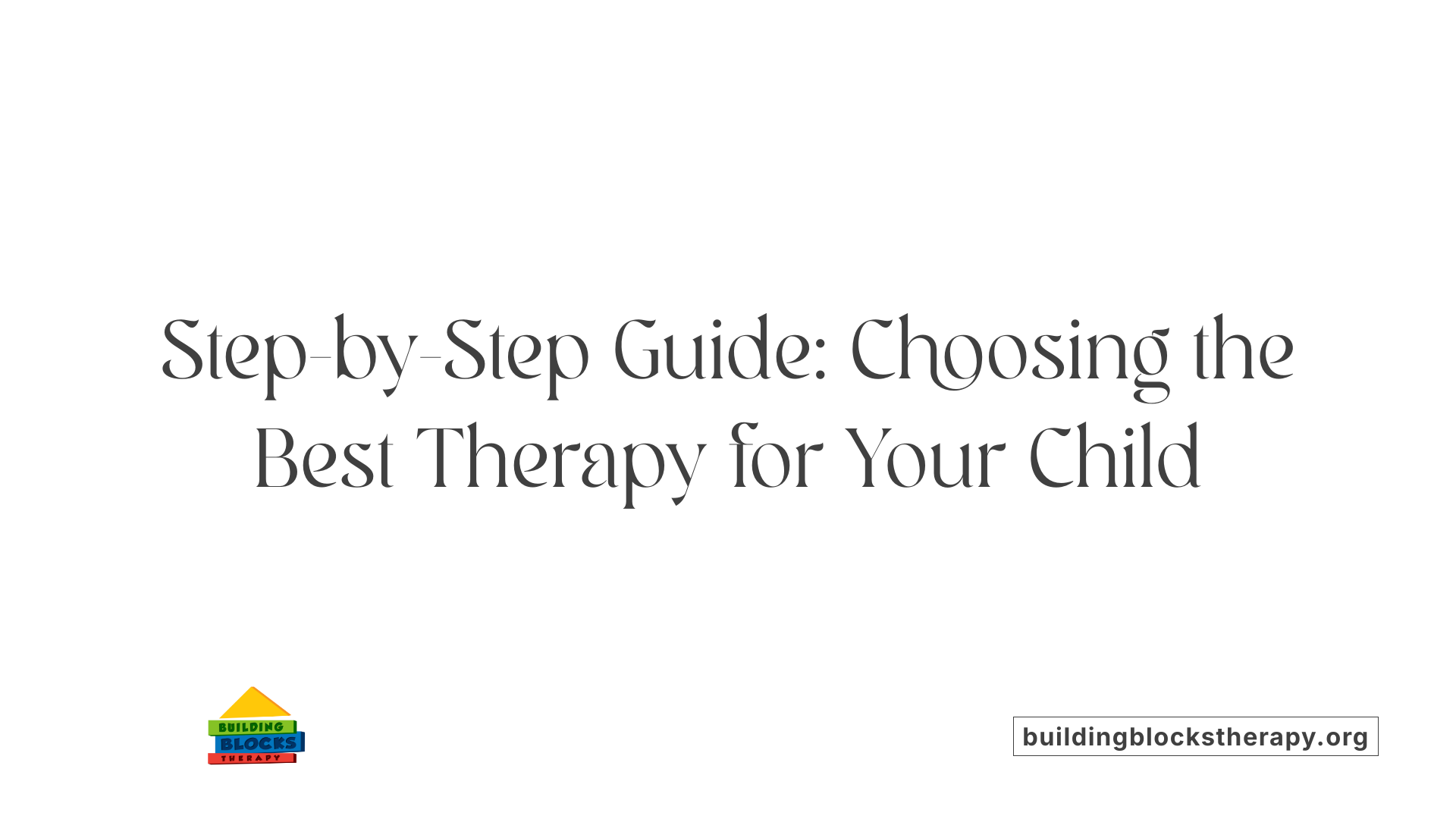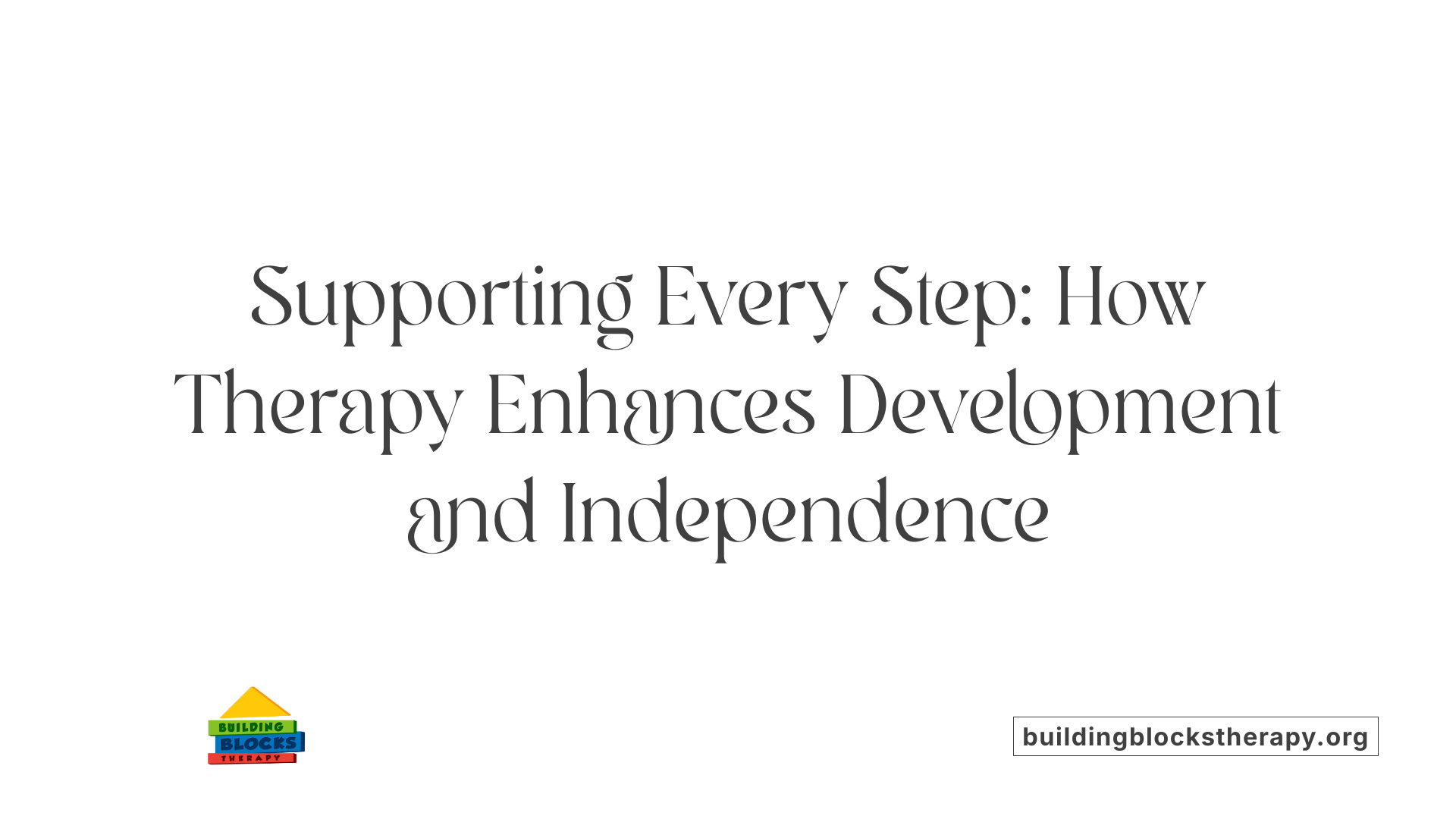How to Choose the Right Therapy for Your Child with Special Needs
Navigating Therapy Options for Children with Special Needs: A Parent’s Guide

Understanding How to Make Informed Therapy Choices for Your Child
Choosing the right therapy for your child with special needs is a crucial step toward supporting their development, independence, and well-being. With a myriad of options available—from behavioral interventions to speech and occupational therapies—parents need to navigate carefully to find the most suitable approach tailored to their child's unique profile. This guide offers comprehensive insights into different therapy types, criteria for selecting qualified providers, and practical tips for making informed decisions that foster lasting positive outcomes.
Understanding Different Types of Therapy for Children with Special Needs

What are the different types of therapies available for children with special needs?
Children with special needs, especially those diagnosed with autism spectrum disorder (ASD), have access to a variety of therapeutic options tailored to their specific development goals. Evidence-based therapies include applied behavior analysis (ABA), speech therapy, occupational therapy, and physical therapy.
ABA therapy is a structured approach that emphasizes positive reinforcement to teach social behaviors, communication skills, and reduce problematic actions. It often involves detailed data collection to track progress. Speech and language therapy focuses on enhancing verbal and non-verbal communication, helping children express themselves and better engage socially. It may include the use of augmentative and alternative communication (AAC) devices.
Occupational therapy (OT) aims to improve daily living skills, such as dressing, eating, and sensory processing, fostering greater independence. Physical therapy supports gross motor skills, balance, and strength development.
Beyond these, therapies like social skills training help children improve peer interactions, while relationship development intervention (RDI) emphasizes flexible thinking and forming bonds with family members. Cognitive-behavioral therapy (CBT) can assist in managing anxiety and emotional regulation.
Often, a multidisciplinary approach, combining several therapies, offers the most comprehensive support. Early intervention—ideally before age 3—is associated with better developmental outcomes. Collaboration between parents, educators, and therapists creates a tailored program that addresses each child’s unique strengths and challenges, helping them reach their full potential.
Selecting the Right Therapy: A Step-by-Step Approach for Parents

How can parents select appropriate and effective therapy options for children with special needs?
Choosing the right therapy for a child on the autism spectrum or with other developmental challenges involves a careful, multi-step process.
First, parents should start with a comprehensive assessment of their child's unique needs. Consulting healthcare professionals, such as pediatricians, psychologists, or specialists in autism, helps identify specific challenges in areas like communication, social skills, behavior, and daily living.
Once the child's needs are understood, parents can explore different treatment options. Evidence-based therapies like Applied Behavior Analysis (ABA), speech and language therapy, occupational therapy (OT), and social skills training have proven effective. It's important to understand the main goals and methods of each therapy to see which aligns best with the child's challenges.
Researching potential providers is essential. Parents should check credentials like licensing, certifications such as BCBA for ABA therapy, and experience working with children with similar needs. Reading reviews, seeking referrals, and asking for references can also help ensure the quality and suitability of the therapist.
Practical factors must not be overlooked. Consider the location of therapy sessions, scheduling flexibility, and whether sessions are in-home, at a clinic, or at school. These aspects influence consistency and comfort.
Monitoring progress regularly with specific, measurable goals allows for ongoing evaluation. Maintaining open communication with therapists, participating in parent training, and adjusting therapy plans as needed ensure the intervention remains effective.
In summary, selecting therapy involves thorough research, assessment, and ongoing collaboration. This approach helps tailor care to each child's needs, maximizing developmental gains and enhancing their quality of life.
Essential Factors to Consider When Choosing a Therapy Provider
What factors should be considered when choosing therapy for children with special needs?
Selecting the right therapy for a child with special needs involves careful consideration of several important factors. First and foremost, understanding the child's specific diagnosis, such as autism spectrum disorder, guides the choice of appropriate therapies. Different conditions and developmental stages may require tailored approaches, making individualized assessment crucial.
Expertise and credentials of the therapist greatly influence the quality of care. It's essential to verify their licensing, certifications (like BCBA or speech-language pathology credentials), and experience working with similar needs. A therapist’s familiarity with evidence-based practices ensures that your child receives scientifically supported interventions.
Practical elements such as location, scheduling, and cost also matter. Therapies should be accessible and fit within family routines, whether offered in-center, at home, or in school settings. Checking insurance coverage may help manage expenses.
The provider’s reputation, reviews, and references from other families can provide insights into their reliability and effectiveness. Observing initial sessions helps gauge how well the therapist relates to your child and whether your child feels comfortable.
Monitoring progress regularly and staying involved in setting goals ensures that therapy remains effective and adaptable. Flexibility to modify therapy methods based on the child's evolving needs is also vital.
In sum, choosing a suitable therapy provider encompasses assessing your child's unique needs, verifying professional credentials, considering practical logistics, and ensuring ongoing, personalized support. Doing thorough research helps ensure your child receives tailored, high-quality care that promotes development and well-being.
Evaluating and Finding Qualified Therapists: A Caregiver’s Guide
 When seeking the right therapist for a child with special needs, thorough evaluation and research are essential. First, caregivers should verify the credentials of potential therapists. This includes checking licenses, certifications, and specific training in evidence-based approaches like ABA, speech therapy, or occupational therapy.
When seeking the right therapist for a child with special needs, thorough evaluation and research are essential. First, caregivers should verify the credentials of potential therapists. This includes checking licenses, certifications, and specific training in evidence-based approaches like ABA, speech therapy, or occupational therapy.
Experience matters too. It’s important to select providers who have worked with children facing similar challenges. Asking about their experience with autism spectrum disorder or other specific conditions can help ensure they are equipped to meet your child's unique needs.
Referrals and recommendations from trusted sources are valuable. Support groups, educators, pediatricians, or reputable organizations such as the American Psychological Association can guide you toward highly qualified therapists.
Meeting with potential providers during initial consultations allows for a better understanding of their approach and personality. It’s helpful to observe the therapist’s methods and engagement style during trial sessions.
Open communication is crucial. Ask about their strategies for progress tracking, how they tailor therapy plans, and how they involve families in the process. Ensuring your child's comfort and the therapist’s understanding of your child's needs can significantly influence therapy outcomes.
Ultimately, choosing a therapist involves balancing credentials, experience, and personal rapport. Caregivers should prioritize environments where their child feels safe, supported, and motivated to participate, paving the way for meaningful developmental progress.
The Benefits of Therapy Options for Children with Special Needs
Different types of therapy can significantly improve various skills and overall well-being for children with developmental challenges, including those on the autism spectrum.
Communication improvement is a primary focus, especially through speech and language therapy. This type helps children develop verbal, non-verbal, and social communication skills, enabling them to express themselves clearly and interact more effectively with others.
Social skills development is often achieved via social skills training and relationship-based interventions like Relationship Development Intervention (RDI). These programs help children understand social cues, form bonds, and navigate social environments with greater confidence.
Daily living skills enhancement is facilitated by occupational therapy, which targets skills such as dressing, eating, and personal hygiene. Improving these independence skills fosters greater self-reliance and self-esteem.
Emotional regulation is supported through therapies like Cognitive Behavioral Therapy (CBT), which helps children manage anxiety, depression, and emotional outbursts by addressing problematic thoughts and behaviors.
Support for mental health is vital, as many children with autism and other developmental disorders experience emotional and behavioral difficulties. Therapies tailored to these needs can improve quality of life and support mental resilience.
What are the benefits of various therapy options, including autism-specific therapies?
| Therapy Type | Main Goals | Methods & Focus | Typical Outcomes |
|---|---|---|---|
| ABA Therapy | Behavior modification, social skills | Reward-based, data-driven, systematic skill-building | Increased communication, social behavior, and independence |
| Speech Therapy | Language and communication skills | Play-based, AAC devices, social language techniques | Better verbal/non-verbal interaction |
| Occupational Therapy | Daily living skills, sensory processing | Motor activities, sensory exercises | Improved self-care, motor skills |
| Cognitive Behavioral Therapy | Emotional management | Talking, thought restructuring | Reduced anxiety, better emotional regulation |
| Relationship Development Intervention | Social bonding, flexible thinking | Parent training, social exercises | Stronger family bonds, social adaptability |
Effective therapy is usually tailored to each child's unique needs, combining different approaches as needed. Early intervention and consistent assessment enhance progress.
By thoroughly researching and selecting qualified, compassionate providers, parents can ensure their children receive the support they need to thrive across many areas of life.
Making Informed Therapy Decisions: The Parent’s Role in Child Development

How can parents make informed decisions about therapy choices for children with special needs?
Parents play a crucial role in selecting the most suitable therapies for their children, especially when dealing with conditions like autism spectrum disorder (ASD), ADHD, or other developmental challenges. The process begins with understanding that therapy options are diverse, including applied behavior analysis (ABA), speech therapy, occupational therapy, and others, each serving different goals and employing various methods.
A fundamental step is engaging in shared decision-making (SDM) with healthcare providers. This approach involves open, honest conversations where parents ask detailed questions about each therapy’s approach, expected outcomes, and the therapist’s qualifications. They should discuss their child's unique needs, strengths, and developmental stage to tailor choices effectively.
Effective communication extends beyond initial discussions. Parents should consider the provider’s credentials, such as certifications like BCBA for ABA or licensure in speech or occupational therapy. Experience working with children with similar profiles can significantly influence therapy success. Checking reviews, seeking referrals, and establishing a relationship based on trust and transparency are vital.
Understanding various treatment techniques within each therapy type allows parents to align their comfort levels and expectations. For example, some families might prefer behavior-based strategies like ABA that focus on reinforcement, while others might prioritize speech and communication methods or sensory integration approaches.
Practical considerations also matter — including therapy location, proximity to home or school, and scheduling flexibility. These factors can impact the child’s consistency in attending sessions and the overall therapy experience.
Parents are encouraged to observe initial therapy sessions to gauge the therapist’s engagement with the child, their ability to create a supportive environment, and how well the child responds. Open dialogue about goals and progress is essential, with ongoing monitoring to track improvements and adjust the plans as necessary.
Using decision aids—such as brochures, online resources, or child life specialists—can help clarify options and prepare families to participate actively in decision-making. Involving children in age-appropriate ways fosters their independence and confidence in managing their care.
Ultimately, making well-informed decisions involves careful research, collaboration with trusted providers, and considering what aligns with the child’s needs and family values. This thoughtful approach ensures that therapy is tailored, effective, and supportive of the child's overall development and well-being.
Supporting Children with Special Needs Through Therapy

How can therapeutic interventions support children with special needs?
Therapeutic interventions are a vital component of supporting children with special needs, particularly those on the autism spectrum. These therapies aim to promote key areas of development, including communication, motor skills, social interaction, and emotional regulation. By addressing these domains, therapy helps children become more independent and improve their overall quality of life.
Each child's needs are unique, so interventions are tailored to fit their specific developmental profile. For example, speech therapy focuses on improving verbal and non-verbal communication, while occupational therapy helps enhance self-care and daily living skills like dressing and eating. Behavioral therapies, such as Applied Behavior Analysis (ABA), encourage positive behaviors and reduce challenging ones.
Beyond individual sessions, integrating therapy within family and school environments is crucial. Family involvement through counseling and training helps create a supportive home atmosphere and equips parents with effective strategies. In educational settings, specialized programs and social skills groups foster peer interactions and address behavioral challenges.
Therapies are most effective when delivered by multidisciplinary teams that include speech-language pathologists, occupational therapists, behavior analysts, and psychologists. These teams collaborate to develop comprehensive care plans that align with the child's goals.
In addition to direct child interventions, family-centered approaches are essential. Parenting programs and support groups help caregivers manage stress and better advocate for their children. School-based therapies and community activities also play a role in supporting ongoing development.
Overall, therapeutic services aim to build skills for learning, socialization, and daily living, creating a foundation for children to thrive both at home and in school. Regular monitoring and flexibility in intervention plans ensure that support adapts as the child grows and their needs change.
Empowering Parents to Make the Best Choices for Their Child
Choosing the right therapy for your child with special needs is a multifaceted process that requires thorough research, collaboration with qualified professionals, and ongoing assessment of progress. By understanding the array of available therapies and factors influencing their success, parents can make informed decisions that align with their child's unique developmental profile. Early intervention, family involvement, and flexible, tailored approaches are key to unlocking your child's potential and ensuring they receive the highest quality care to thrive academically, socially, and emotionally.
References
- Tips for Choosing the Right Therapy Provider for Your Child
- Types of Therapy for Autism: 5 Options for Autistic Kids
- Autism Therapy Types & Interventions
- Ultimate Guide To Choosing The Right ABA Therapy For ...
- How to Choose the Right Behavioral Therapist for Your ...
- Finding the Right Child Therapist: A Guide for Parents
- How to Choose the Right Behavioral Therapist for Your ...






